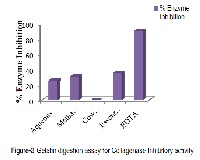Antibacterial, Antioxidant, Collagenase inhibition, Urease inhibition activities and Chemical composition of the Essential oil and extracts of Cinnamomum zeylanicum bark.
Keywords:
Cinnamomum zeylanicum, Antibacterial activity, Minimum inhibitory concentration, Essential oil, Collagenase, Urease, Antioxidant activityAbstract
Significant biological activities of bacterial infection like antibacterial, antioxidant, urease and collagenase inhibitory activities of the essential oil and various extracts of Cinnamomum zeylanicum were determined. The in vitro antibacterial activity against nine epidermal bacteria and 11 MRSA isolates was conducted. The essential oil of C. zeylanicum exhibited the activity against all bacteria with the Minimum Inhibitory Concentration values (MIC) ranging from 0.15 to 2.5 µl. The extracts showed declined antibacterial activity. The scanning electron microscopic (SEM) studies demonstrated potential detrimental effect of the essential oil on the morphology of tested bacteria. Antioxidant activity of all the samples was also determined and 20% activity was observed in essential oil. Collagenase inhibitory potential was upto 25% and 30% in aqueous and methanol extracts respectively while upto 35% in essential oil. None of the samples showed urease inhibitory activity. The chemical composition of hydrodistilled essential oil of C. zeylanicum was also analysed by GC-MS. A total of 13 compounds representing 100% of the oil were identified. Therefore, due to different chemical components present in the cinnamon essential oil, further investigation concerned with studied activities of this essential oil to replace the medicines or as supplement in diseases, is recommended.
References
. Inouye S, Yamagachi H, Takizawa T. Screening of the antibacterial effects of a variety of essential oils on respiratory tract pathogens, using a modified dilution assay method. J. Infect. Chemother. 2001;7: 251-254.
. Juglal S, Govinden R, Odhav B. Spices oils for the control of co-occurring mycotoxin producing fungi. Food Prot. 2002; 65: 683-687.
. Mishra AK, Mishra A, Kehri H.K, Sharma B, Pandey A.K. Inhibitory activity of Indian spice plant Cinnamomum Zeylanicum extracts again Alternaria solani and Curvuluria lunata, the pathogenic dematiaceous Moulds. Ann Clin Microbiol Antibacterials. 2009; 8(9).
. Durackova Z. Some current insights into oxidative stress. Physiol. Res. 2010; 59: 459-469.
. Reuter S, Gupta SC, Chaturvedi MM., Aggarwal BB. Oxidative stress, inflammation, and cancer: How are they linked? Free Radic. Biol. Med. 2010; 49: 1603-1616.
. NCCLS,(National Committee for Clinical Laboratory Standards) . Methods for dilution Antibacterial Susceptibility Tests for Bacteria that Grow Aerobically, Approved Standard.2000; M7-A5.
. Mc Farland, J. Standardization of bacterial Culture for disc diffision assay. J Am Med Assoc 1987; 49:1176-1178.
. Kockro RA, Hampl JA, Jansen B, Peters G, Scheihing M, Giacomelli R. Use of scanning electron microscopy to investigate the prophylactic efficacy of rifampin-impregnated CSF shunt catheters. J Med Microbiol.2000;49: 441–450.
. Weatherburn MW. Anal. Chem.1967; 39:971-974.
. SAS Institute; SAS/STAT- User’s Guide, version 9.2, SAS Institute, Cary, NC, USA, 2010.
. El- Baroty GS, Abd El-Baky HH, Farag RS, Saleh MA. Characterization of antioxidant and antibacterial compounds of cinnamon and ginger essential oils. Afr. J. of Biochem. 2010; 4(6):167-174.
. Brand WW, Cuvelier MC, Berset C. Use of free-radical method to evaluate antioxidant activity. LWT. 1995; 28: 25-30.
. Soares JRT, Dinis CP, Cunha AP and Ameida LM. Antioxidant activity of some extracts of Thyms zygis. Free Rad. Res.1997; 26: 469-478.
. Thring T, Hili P, Naughton D P. Anti-collagenase, anti-elastase and anti-oxidant activities of extracts from 21 plants. BMC Complement Altern Med. 2009; 9:27.
. Lateef M, Iqbal L, Fatima N, Siddiqui K, Afza N, Zia-ul-HaqM, Ahmad M. Pak. J. Pharm. Sci. 2012; 25(1): 99-102.
. Ghous T, Akhtar K, Nasim F, Choudhry M A. Screening of selected medicinal plants for urease inhibitory activity. Biol Med. 2010; 2 (4): 64-69,



